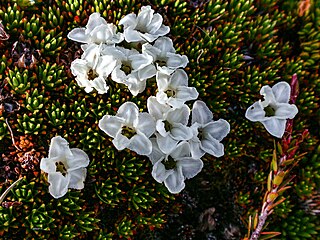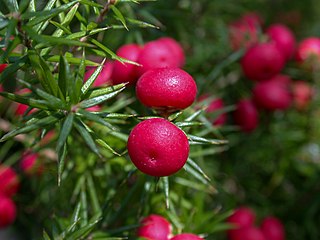Bolster heath or cushion moorland is a type of vegetation community that features a patchwork of very low growing, tightly packed plants found at the limits of some alpine environments. The cushion plants form a smooth surfaced 'cushions' from several different plants, hence the common name of cushion heath. The cushion growth habit provides protection against the desiccating wind and help keep the cluster warm.

Diselma archeri is a species of plant of the family Cupressaceae and the sole species in the genus Diselma. It is endemic to the alpine regions of Tasmania's southwest and Central Highlands, on the western coast ranges and Lake St. Clair. It is a monotypic genus restricted to high altitude rainforest and moist alpine heathland. Its distribution mirrors very closely that of other endemic Tasmanian conifers Microcachrys tetragona and Pherosphaera hookeriana.

A cushion plant is a compact, low-growing, mat-forming plant that is found in alpine, subalpine, arctic, or subarctic environments around the world. The term "cushion" is usually applied to woody plants that grow as spreading mats, are limited in height above the ground, have relatively large and deep tap roots, and have life histories adapted to slow growth in a nutrient-poor environment with delayed reproductivity and reproductive cycle adaptations. The plant form is an example of parallel or convergent evolution with species from many different plant families on different continents converging on the same evolutionary adaptations to endure the harsh environmental conditions.

Donatia novae-zelandiae is a species of mat-forming cushion plant, found only in New Zealand and Tasmania. Common names can include New Zealand Cushion or Snow Cushion, however Snow Cushion also refers to Iberis sempervirens. Donatia novae-zelandiae forms dense spirals of thick, leathery leaves, creating a hardy plant that typically exists in alpine and subalpine bioclimatic zones.

Ewartia planchonii, commonly known as creeping cushionherb, is an endemic herb to alpine areas of Tasmania. E. planchonii is commonly found in the western highlands of Tasmania. The Ewartia genus is described as cushion plants/herbs due to the characteristic growth habits of low growing, highly compact mats which are made up of highly packed stems. These mats are slow-growing and are often located in soils that contain low nutrients.

Ozothamnus ferrugineus, commonly known as tree everlasting, is a member of the genus Ozothamnus, of the Asteraceae family – one of the largest families of flowering plants in Australia. Native to the Australian states of New South Wales, Victoria, South Australia, and Tasmania, it forms an erect shrub or small tree between 2 and 3 metres in height.

Richea pandanifolia, the pandani or giant grass tree, is a distinctive endemic Tasmanian angiosperm. It is dicot of the family Ericaceae and is found in central, western and south west Tasmania. It is a favourite among hikers and nature lovers.

Pterygopappus is a genus of flowering plants in the tribe Gnaphalieae within the family Asteraceae. There is only one known species, Pterygopappus lawrencii, which is endemic to alpine Tasmania. It forms thick, light blue/green mats with densely packed leaves. It is most common in the mountains of the northeastern part of the island. It is a slow grower and prefers cool, moist environments.

Dracophyllum milliganii is a species of angiosperm in the family Ericaceae and the sub-family Epacridoideae. It is a distinctive alpine shrub, endemic to western Tasmania.

Gleichenia alpina, commonly known as alpine coral-fern, is a small fern species that occurs in Tasmania and New Zealand. It grows in alpine and subalpine areas with moist soils and is a part of the Gleichrniaceae family.

Tasmanian cushion plants are low growing, highly compact, woody, spreading mats that can grow up to 3 m in diameter, located mainly on the island of Tasmania. These mats are made up of tightly packed stems that grow at the same rate so that no apical rosettes protrude above the rest. The term cushion plant refers to a characteristic growth habit adopted by various species from a range of families to adapt to alpine and subalpine environments and areas of high latitude. They are adapted to grow in low nutrient areas and typically have deep taproots. Cushion plants are very slow growing and do not grow high above ground; mounds typically remain under 30 cm high. Underneath the living surface of the cushion, the plants either allow dead leaves to persist or produce non-photosynthetic material, resulting in an insulating effect.

Astelia alpina called pineapple grass, silver astelia, or perching lily is a commonly found species in alpine and subalpine areas of Tasmania and the Australian Alps. It is a perennial herb that typically dominates its environment by growing in dense clusters, called mats, in alpine bogs. There are two subspecies: Astelia alpina var. novae hollandiae from New South Wales and Victoria and Astelia alpina var. alpina endemic to Tasmania. Both subspecies appear very similar to each other. The species was originally described by Robert Brown.

Trochocarpa thymifolia is a species of flowering plant from the family Ericacae and is endemic to Tasmania. It is a widespread alpine and subalpine shrub with small leaves, pink to red flowers and blue to purple fruit. Originally described by botanist Robert Brown in 1810, it is a widespread Tasmanian endemic that inhabits the state's mountain regions.

Trochocarpa gunnii, commonly known as sweet-scented trochocarpa or fragrant purpleberry, is a common rainforest understorey shrub from the plant family Ericaceae endemic to Tasmania.

Trochocarpa cunninghamii is a flowering plant species of the family Ericaceae. It is commonly referred to as straggling purpleberry due to its round flattened mauve drupe fruits. This woody shrub is usually found in the understorey of rainforests and subalpine forests in the Central Plateau and western Tasmania, and is endemic to Tasmania.

Abrotanella scapigera is an endemic angiosperm of Tasmania, Australia. It is a member of the family Asteraceae, commonly found in alpine regions of northwest and south-central Tasmania. This species is named after its characteristic sparsely leaved flowering stem that distinguishes it from the other 18 species of the Genus.

Olearia ledifolia, commonly known as rock daisy bush, is a species of flowering plant of the family Asteraceae. It is endemic to Tasmania and found at higher altitudes where it grows as a low, compact bush with tough, leathery leaves and small white and yellow daisy-like "flowers" in summer.

Dracophyllum minimum, commonly known as heath cushionplant or claspleaf heath, is a species of bolster cushion plant endemic to Tasmania, Australia. It is a low growing, highly compacted plant with white flowers, commonly found in alpine areas of the south, centre and west of Tasmania.

Ewartia meredithiae, commonly known as the rusty cushion plant, is a Tasmanian endemic cushion plant species. Out of the four species in Australia from this small genus, Tasmania has three, all of which are low growing, alpine species.

Leptecophylla oxycedrus, commonly referred to as coastal pinkberry or crimson berry, is a medium shrub to large tree native to Tasmania and southern Victoria. It is part of the family Ericaceae and has narrow, pointed leaves, white flowers and pale pink fruits. It was previously classified as a subspecies of Leptecophylla juniperina but has since been raised to the specific level in 2017. The species was originally described in 1805 by Jacques Labillardière in Novae Hollandiae plantarum specimen which was published after his voyage through Oceania.





















